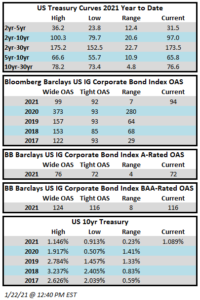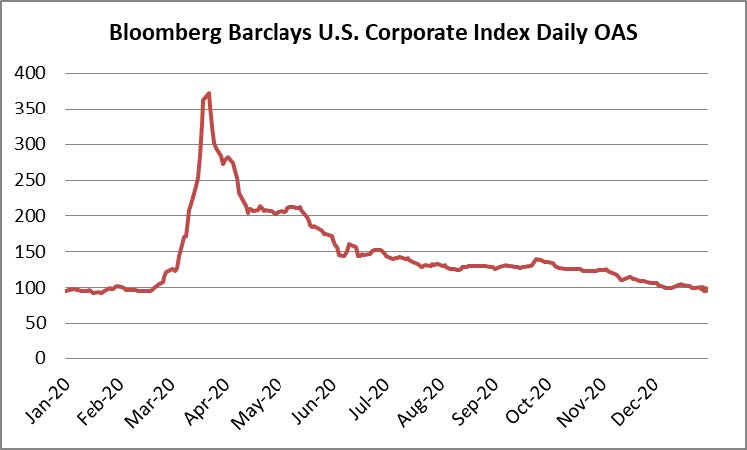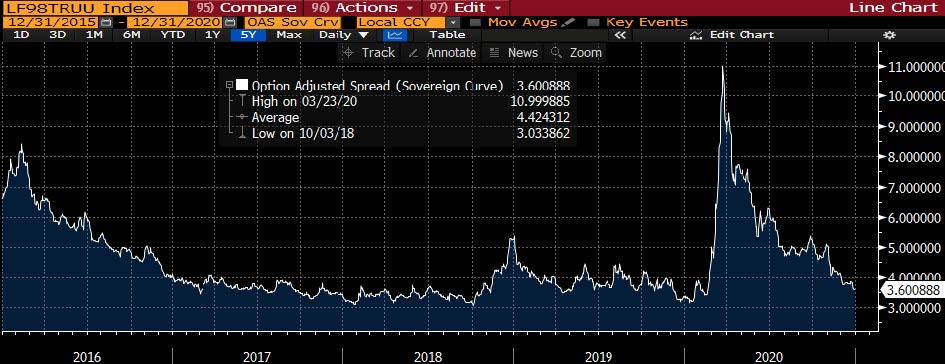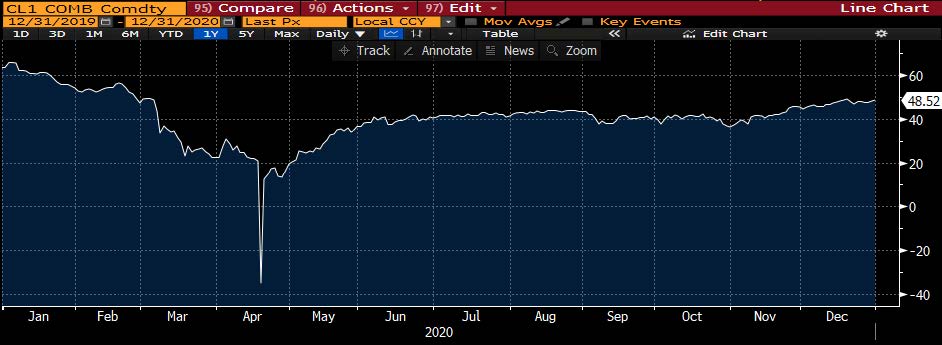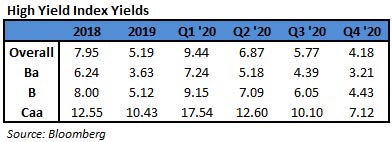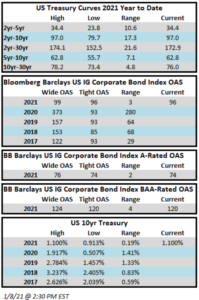Fund Flows & Issuance: According to a Wells Fargo report, flows week to date were -$0.3 billion and year to date flows stand at -$0.3 billion. New issuance for the week was $16.7 billion and year to date issuance is at $32.9 billion.
(Bloomberg) High Yield Market Highlights
- Yields on CCC debt, the riskiest of junk bonds, have hit an all-time low of 6.42% as investors seek bigger returns by moving down the credit curve. US LBM Holdings is the latest borrower to reap rewards from that chase, receiving more than $2.5 billion of demand for a $400 million pay-in-kind bond with ratings in the CCC tier to fund a dividend to Bain Capital.
- The recent CCC tightening has been driven by bond-level performance rather than shifts in the index constituents, Barclays Plc credit strategists led by Brad Rogoff wrote in a note Friday
- There is still room for higher-beta credits to compress, but investors should be selective given some continued Covid-related weakness.
- The CCC index has rallied for 20 straight sessions to post gains of 0.17% on Thursday, and has outperformed other parts of junk for about 11 weeks, according to data compiled by Bloomberg
- Yields on the broader junk bond index also dropped to a record low of 4.10%, though the rally may stall with credit risk higher, stock futures falling and oil prices lower amid renewed fears that the spread of coronavirus may force more lockdowns
- S. high-yield funds reported an outflow for week, the third straight week of exits, but new issues are still being inundated with demand
- The market stands about $2.5b away from making this month the busiest January ever as companies continue to churn out debt offerings to meet voracious demand
(CNBC) IEA cuts 2021 oil demand outlook
- The IEA said it now expects world oil demand to recover by 5.5 million barrels per day to 96.6 million this year. That reflects a downward revision of 0.3 million barrels from last month’s assessment.
- The report comes as countries continue to implement strict public health measures in an attempt to curb virus spread, with lockdowns imposed in Europe and parts of China.
- Oil prices have rallied in recent weeks, supported by optimism over Covid vaccine rollouts and a surprise oil production cut from OPEC kingpin Saudi Arabia.
- “The global vaccine roll-out is putting fundamentals on a stronger trajectory for the year, with both supply and demand shifting back into growth mode following 2020′s unprecedented collapse,” the IEA said in its closely-watched report.
- “But it will take more time for oil demand to recover fully as renewed lockdowns in a number of countries weigh on fuel sales,” it added.
(New York Times) Biden Cancels Keystone XL Pipeline and Rejoins Paris Climate Agreement
- President Biden on Wednesday recommitted the United States to the Paris climate agreement, the international accord designed to avert catastrophic global warming, and ordered federal agencies to start reviewing and reinstating more than 100 environmental regulations that were weakened or rolled back by former President Trump.
- Biden has elevated tackling the climate crisis among his highest priorities.
- “We’re going to combat climate change in a way we have not before,” Mr. Biden said in the Oval Office on Wednesday evening, just before signing the executive orders. Even so, he cautioned: “They are just executive actions. They are important but we’re going to need legislation for a lot of the things we’re going to do.”
- Also on Wednesday, Mr. Biden rescinded the construction permit for the Keystone XL oil pipeline, which would have transported carbon-heavy oil from the Canadian oil sands to the Gulf Coast. Earlier in the day, TC Energy, a Canadian company, said that it was suspending work on the line
(CAM Note) As we go to print, the WTI crude oil price is down 2.5%.
